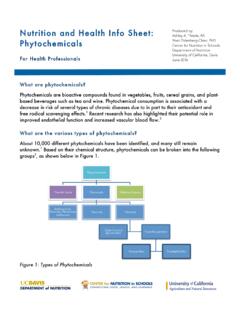Transcription of THE p -BLOCK ELEMENTS - NCERT
1 307 C:\ChemistryXI\Unit-11\Unit-11-F\Unit-11 (reprint).pmd, Reprint p -BLOCK ELEMENTSUNIT 11 After studying this unit, you will beable to appreciate the general trends in thechemistry of p -BLOCK ELEMENTS ; describe the trends in physical andchemical properties of group 13 and14 ELEMENTS ; explain anomalous behaviour ofboron and carbon; describe allotropic forms of carbon; know the chemistry of someimportant compounds of boron,carbon and silicon; list the important uses of group 13and 14 ELEMENTS and p - block ELEMENTSIn p -BLOCK ELEMENTS the last electron enters the outermostp orbital.
2 As we know that the number of p orbitals is threeand, therefore, the maximum number of electrons that canbe accommodated in a set of p orbitals is six. Consequentlythere are six groups of p block ELEMENTS in the periodictable numbering from 13 to 18. Boron, carbon, nitrogen, oxygen , fluorine and helium head the groups. Their valenceshell electronic configuration is ns2np1-6(except for He).The inner core of the electronic configuration may,however, differ. The difference in inner core of elementsgreatly influences their physical properties (such as atomicand ionic radii, ionisation enthalpy, etc.)
3 As well as chemicalproperties. Consequently, a lot of variation in properties ofelements in a group of p -BLOCK is observed. The maximumoxidation state shown by a p -BLOCK element is equal to thetotal number of valence electrons ( , the sum of the s-and p-electrons). Clearly, the number of possible oxidationstates increases towards the right of the periodic table. Inaddition to this so called group oxidation state, p-blockelements may show other oxidation states which normally,but not necessarily, differ from the total number of valenceelectrons by unit of two.
4 The important oxidation statesexhibited by p -BLOCK ELEMENTS are shown in Table Inboron, carbon and nitrogen families the group oxidationstate is the most stable state for the lighter ELEMENTS in thegroup. However, the oxidation state two unit less than thegroup oxidation state becomes progressively more stablefor the heavier ELEMENTS in each group. The occurrence ofoxidation states two unit less than the group oxidationstates are sometime attributed to the inert pair effect .The variation in properties of the p -BLOCK ELEMENTS due to theinfluence of d and f electrons in the inner core of the heavierelements makes their chemistry interesting307 C:\ChemistryXI\Unit-11\Unit-11-F\Unit-11 (reprint).
5 Pmd, , (reprint) NCERTnot to be republished308 C:\ChemistryXI\Unit-11\Unit-11-F\Unit-11 (reprint).pmd, Reprint relative stabilities of these two oxidationstates group oxidation state and two unit lessthan the group oxidation state may vary fromgroup to group and will be discussed atappropriate is interesting to note that the non-metalsand metalloids exist only in the p -BLOCK of theperiodic table. The non-metallic character ofelements decreases down the group. In fact theheaviest element in each p -BLOCK group is themost metallic in nature.
6 This change from non-metallic to metallic character brings diversityin the chemistry of these ELEMENTS dependingon the group to which they general, non-metals have higher ionisationenthalpies and higher electronegativities thanthe metals. Hence, in contrast to metals whichreadily form cations, non-metals readily formanions. The compounds formed by highlyreactive non-metals with highly reactive metalsare generally ionic because of large differencesin their electronegativities. On the other hand,compounds formed between non-metalsthemselves are largely covalent in characterbecause of small differences in theirelectronegativities.
7 The change of non-metallicto metallic character can be best illustrated bythe nature of oxides they form. The non-metaloxides are acidic or neutral whereas metaloxides are basic in first member of p -BLOCK differs from theremaining members of their correspondinggroup in two major respects. First is the sizeand all other properties which depend on , the lightest p -BLOCK ELEMENTS show thesame kind of differences as the lightest s-blockelements, lithium and beryllium. The secondimportant difference, which applies only to thep -BLOCK ELEMENTS , arises from the effect of d-orbitals in the valence shell of heavier ELEMENTS (starting from the third period onwards) andtheir lack in second period ELEMENTS .
8 Thesecond period ELEMENTS of p-groups startingfrom boron are restricted to a maximumcovalence of four (using 2s and three 2porbitals). In contrast, the third period elementsof p-groups with the electronic configuration3s23pn have the vacant 3d orbitals lyingbetween the 3p and the 4s levels of these d-orbitals the third periodelements can expand their covalence abovefour. For example, while boron forms only[BF4] , aluminium gives [AlF6]3 ion. Thepresence of these d-orbitals influences thechemistry of the heavier ELEMENTS in a numberof other ways.
9 The combined effect of size andavailability of d orbitals considerablyinfluences the ability of these ELEMENTS to form bonds. The first member of a group differsfrom the heavier members in its ability to formp - p multiple bonds to itself ( , C=C, C C,Table General Electronic Configuration and Oxidation States of p -BLOCK ElementsGroup131415161718 Generalelectronicns2np1 ns2np2ns2np3ns2np4ns2np5ns2np6configurat ion(1s2 for He)First memberof theBCNOFH egroupGroupoxidation +3 +4 +5 +6+7 +8stateOtheroxidation+1+2, 4+3, 3+4, +2, 2 +5, + 3, +1, 1+6, +4, +2states308 C:\ChemistryXI\Unit-11\Unit-11-F\Unit-11 (reprint).)
10 Pmd, , (reprint) NCERTnot to be republished309 C:\ChemistryXI\Unit-11\Unit-11-F\Unit-11 (reprint).pmd, Reprint p -BLOCK ELEMENTSN N) and to other second row ELEMENTS ( ,C=O, C=N, C N, N=O). This type of - bondingis not particularly strong for the heavierp -BLOCK ELEMENTS . The heavier ELEMENTS do form bonds but this involves d orbitals (d p or d d ). As the d orbitals are of higherenergy than the p orbitals, they contribute lessto the overall stability of molecules than doesp - p bonding of the second row , the coordination number in speciesof heavier ELEMENTS may be higher than forthe first element in the same oxidation example, in +5 oxidation state both N andP form oxoanions : NO3 (three-coordinationwith bond involving one nitrogen p-orbital)and 34PO (four-coordination involving s, p andd orbitals contributing to the bond).










